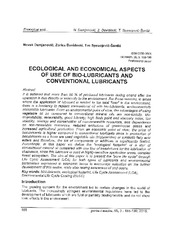Приказ основних података о документу
Economical and ecological aspects of use of bio-lubricants and conventional lubricants
| dc.creator | Damjanović, Novak | |
| dc.creator | Davidović, Zorica | |
| dc.creator | Spasojević-Šantić, Tea | |
| dc.date.accessioned | 2022-09-23T06:45:42Z | |
| dc.date.available | 2022-09-23T06:45:42Z | |
| dc.date.issued | 2016 | |
| dc.identifier.issn | 0350-350x | |
| dc.identifier.uri | http://rims.institutims.rs/handle/123456789/424 | |
| dc.description.abstract | It is believed that more than 50% of produced lubricants during or/and after the operation is due directly or indirectly to the environment. For these reasons, in areas where the application of lubricant is related to the total „loss“ in the environment, there is a tendency to replace conventional oil with bio-lubricants, environmenrally acceptable lubricants. From an environmental point of view, the advantages of using vegetabče oil as compared to conventional mineral oils are non-toxicity, bio-degradability, renewability, good lubricity, high flash point and viscosity index, low volatility, savings and conservation of non-renewable resources, less dependence or non-renewable resources, reduced emissions of greenhouse gases and increased agricultural production. From an economic point of view, the price of biolubricants is higher compared to conventional lubricants since in production of biolubricants as a base is used vegetable oils (triglycerides) pr synthetic fatty acid esters and therefore , the list of components or additives is significantly limited. Accordingly, in this paper we define the „ecological footprint“ of a liter of conventional mineral oil compared with one liter of biolubricant for the lubrication of chainsaws, since this lubricant is used in highly-sensitive application areas, complex forest ecosystem. The aim of this paper is to present the „pure life cycle“ through Life Cycle Assessment (LCA) for both types of lubricants and environmental parameters expressed in economic terms to encourage reflection on the further development of this sector, while also raising awareness of end-users. | sr |
| dc.language.iso | en | sr |
| dc.rights | openAccess | sr |
| dc.rights.uri | https://creativecommons.org/licenses/by/4.0/ | |
| dc.source | Goriva i maziva, 55, 3 | sr |
| dc.subject | Biolubricants | sr |
| dc.subject | Ecological footprint | |
| dc.subject | Life Cycle Assessment (LCA) | |
| dc.subject | Environmental Life Cycle Costing (ELCC) | |
| dc.title | Economical and ecological aspects of use of bio-lubricants and conventional lubricants | sr |
| dc.type | article | sr |
| dc.rights.license | BY | sr |
| dc.citation.epage | 199 | |
| dc.citation.spage | 188 | |
| dc.citation.volume | 3 | |
| dc.identifier.fulltext | http://rims.institutims.rs/bitstream/id/983/bitstream_983.pdf | |
| dc.identifier.rcub | https://hdl.handle.net/21.15107/rcub_rims_424 | |
| dc.type.version | publishedVersion | sr |

